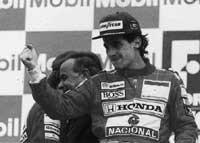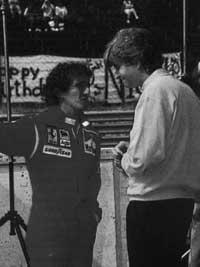Helmet on head and walk around the world
On 15 July 1990, at the famous Silverstone circuit in Britain, the French driver Eric Bernard had visual problems in his fireball Lamborghini. He saw the shapes and colors faded, the panel could not read and could not distinguish the fireballs from the competition. The reason was the resonance of two types of vibrations of 80 and 90 hertz frequency. As the tire erodes, the pilot suffers these vibrations along with his retina or natural vibrations in the network. The amplitude of the vibrations grew and visual problems arose.

In principle, when the pilot goes down the track, he has some obstacles to get visual information. For example, the huge noise produced by the fireball engine can be a factor of visual imbalance. This is what researchers at the French organisation IBSV (Institut Biomedical Sports and Vie) suspect. This organization has been studying the physical and psychological barriers of Formula 1 drivers since 1988.
Astronauts and hunting pilots have to govern another dimension in space and when the equilibrium organ is very activated they sometimes have difficulty integrating visual stimuli. Therefore, even in terrestrial cars, when auditory functions are activated, visual imbalances can occur.
When the pilot takes a curve during the race, he suffers tangential accelerations of 3, 4 and 5 G. (The G number indicates the load factor corresponding to an acceleration of 9.8 m/s 2. For example, when it comes to 3G accelerations, the weight is three times higher.) The head, equipped with Kmucho, actually weighs 6.5 kilos, but due to tangential acceleration this weight multiplies. Consequently, the neck muscles require enormous forces to control the head. However, having to take the curves very often in the race circuit, the muscular resistance of the neck is affected. The head suffers uncontrolled movements due to the effect of centrifugal force, which disturbs the pilot's visual information collection system.
To avoid this obstacle, pilots limit the movement of the helmet by placing some straps on the armpit. The length of the straps must be precisely regulated, since the neck swing prevents synchronization between the neck and the eyeballs.
After analyzing the helmets currently used by the drivers of Formula 1, it has been proven that they have many defects. On the one hand, they have a “hole” too small to see the environment, and on the other, the visors they use are not appropriate, since they deform the image and cause visual fatigue. Also, given the light state, pilots often incorrectly choose the color of the viewfinder filter. Therefore, poorly selected visors produce distortions in colors and contrasts, and the recommendation to choose them correctly is yellow in rainy or cloudy times and gray in sunny times.
Another problem that affects the psychology of the pilot. And it is that when the pilot stops looking for a moment the asphalt track and fixes his gaze on the data that the fireball computer offers on the screen, the eyes must change its axis and depth of field. For this you need a second and a half. When you look back on the road, your eyes take so long to adjust, that is, three seconds in total. You have to think that there is no other way out for the pilot and it is a bad thing to look at the screen on the straight stages of the circuit. But this means that some data of interest, such as engine regime, cannot be known in curves.


But there is a solution. The pilot can view the screen data without lowering the view through the Racing Helmet Display (RHD) system. Lotus first tested it in 1992 and has since been developed by GEC Avionics and Frazer Nash Technology. This is a small screen installed on the hull, similar to that used by several aircraft and helicopter pilots during the Gulf War. (See Elhuyar. Science and Technology. Number 46.
April 1991. “Night helmet for drivers”. Article by Jon Otaolaurretxe). Between the eye and the helmet is a small optical lens in which technical parameters appear, artificially surpassing the landscape. Thus, the eye of the pilot always looks forward and in the meantime has the necessary information, without the need for the adjustment times of the eyes of three seconds.
In the private tests conducted on the circuit, the pilots of Johnny Herbert and Mika Kakkin have been able to see in the visor the figures indicating the engine regime, the row of luminous points that marks when it is convenient to change the position of the gearbox, a green light that turns on when it is convenient to introduce a faster speed and a red pilot that turns on when the engine is too fast or is in danger.
It seems that this system is being tested by the Lotus. However, aeronautics experts say that it is not enough to give the data on the plane or fireball panel. Data delivery to the pilot by treatment. On aircraft, the route to follow is provided to the driver from three coordinates by a symbol, but the Racing Helmet Display system offers no tactical or strategic help to the Formula 1 driver. On the other hand, the optical lens facing the right eye of the pilot does not exactly match the axis of the gaze fixed on the track, which means a small time of adaptation. The system needs to be improved.
Today, the pilot of the formula that is inserted in his fireball seat, in addition to enduring heat, strong accelerations, vibrations and stress, sees that many parameters and data come to him and, for his excessive work in the management of all of them, is about to fail. Therefore, in the field of artificial intelligence, expert systems are being prepared so that the pilot can conduct a detailed analysis of the information and make the appropriate decision. As in the case of aeronautics, it is intended to make available to the machine much of the pilot's perception tasks so that the pilot can use his intelligence and his time in the realization of his tactical and strategic possibilities. Consequently, in pairs of people/machines the expert systems will treat the information and the pilot will make decisions.
Through expert systems, the pilot, in a curve and with wet soil, would know the margin of the fireball until it slips on the ground, since through a cursor this information would be provided. The same can be said of the motor mode. And he would also be informed that he would not collide between the clouds of water that the previous fireballs raise to the rain. All this seems to be at the limit of science fiction, but thanks to advances in computer science it cannot be said to be a dream.
At the moment, FISA (Federation Internationale du Sport Auto) refuses to use this type of advance in racing. But there is also another obstacle, the weight of the helmet. Although only a few hundred grams would be added, this weight should be multiplied by the factor due to accelerations (to the G above). Therefore, a solution can be to send information from the fireball panel to the helmet using radio waves. The projection of images with difractive optics on curved surfaces, that is, on the visor of the helmet, would also be a suitable solution, since it would not be necessary to place an optical lens in front of the pilot.

Should pilots be denied the help of new electronic systems? This is what FISA, Formula 1 racing management entity, has decided. It seems that fireball is becoming too sophisticated and in research there are houses that spend large amounts of money, increasing the distance between big and small motorists. In addition, the pilot's participation in the race victory is getting smaller, although his work is increasingly complex. Sports fans seek suspensse and excitement in the race, slowing the speed of progress. Therefore, they want to leave the data out of the races. In July 1993, the FISA World Commission renounced the demands of the houses of Williams and McL and banned active suspension and anti-slip system in fireballs. Motorists with fewer resources, such as the Ferrari house, have welcomed this decision. Among the drivers of the formula are all kinds of opinions on the limitation of technological advances. According to the Brazilian Ayrton Senna, if it were to go back in technology, the necessary level would be given to the art of piloting. For his part, the Frenchman Alain Prost seems favorable to the advances, since the role of the pilot would be more intellectual. |





